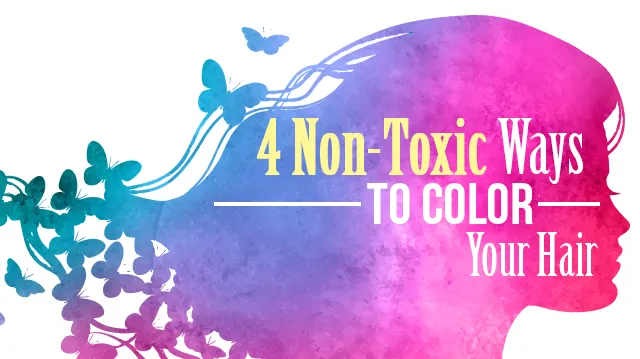Do you know your natural hair color? The answer may seem obvious, but according to one study, one in six UK women have been dyeing their hair for so long, they no longer know what their natural color is. In terms of frequency, participants colored their hair on average every 8.2 weeks.
In the United States, a 2008 study by Clairol showed that 75 percent of American women color their hair and 88 percent said that their hair has an effect on their confidence. The point is, coloring one’s hair has become the norm, and both men and women are often not aware of the potential risks involved.
The dangers associated with hair coloring
Toxic hair dyes contain two key components: a color and a developer. The developer is what contains hydrogen peroxide and ammonia. These essentially modify the hair shaft so that color molecules can penetrate and bond to your hair. Once applied, carcinogenic substances known as arylamines are absorbed through the skin.
While focusing on the use of hair dye, the potential long-term effects have been studied closely. More specifically, researchers are interested in the associated risk of cancer in terms of hair-dyeing products — and have been for the past several decades. If there is a significant link, hair dye could essentially be a public health concern.
Within a number of studies, the chemicals found in hair dyes appear to be mutagenic in vitro, carcinogenic to animals and have shown the ability to penetrate human skin. In a study published in the American Journal of Epidemiology, researchers reported that the long-term use of permanent dye may have a larger impact on adult acute leukemia than data has suggested in the past.
A study published in PloS reported that the odds of developing breast cancer increased by 23 percent among women who colored their hair, in comparison to those who did not. These findings have been repeated throughout a wide range of studies. Researchers have noted that due to the popularity of hair dye in modern societies, routine hair coloring is a potential public health hazard.
Still want to color your hair? Try one of these non-toxic methods
When dyeing your hair naturally, you often need to take a progressive approach, although some will offer immediate results. Whether you have blonde, brown or red hair, here are some non-toxic solutions to elevate the look of your hair without exposing yourself to harmful chemicals.
Exclusive: 4 Natural Hair Treatments For Shiny And Gorgeous Locks
Want lighter hair? Squeeze a lemon
It’s no secret that lemon is great for your skin, but did you know it can also lighten your hair? Lemon acts as a natural bleaching agent, and although you won’t be bleached blonde, you can lighten your hair by at least half a shade after one use.
This technique provides a more natural look — all you need is a lemon and the sun. When the acid in the lemon juice combines with oxygen and UV rays, your hair experiences acid oxidation, and in turn, you benefit from natural highlights. The active ingredient is called limonene and is most concentrated in the rind.
Have black hair? Black walnuts are all you need
It’s been said that black walnut is one of the most powerful ways to naturally color your hair. Although it will not instantly turn your hair jet black, it’s a great way to naturally darken and enrich your hair — it even covers grays. When handling the husks, make sure you wear gloves and protect your clothing.
Simply peel the black walnut husks and place them in a pot of boiling water, reduce the heat and then simmer for 15 to 20 minutes. Once you strain the cooled dye into a bottle, add a carrier oil of your choice — jojoba oil tends to work well. To thicken, also add some all-natural conditioner. Apply, and after 30 minutes rinse thoroughly.
If you’re a redhead, beet juice and tea are for you
If you’re looking to add depth to naturally red hair or would like to add red tints to your current color, the combination of beet juice and black tea is very effective. Beets contain a pigment known as betalain, which also act as a powerful antioxidant. When combined with black tea, your hair and scalp benefit from both antioxidants and tannins.
It’s been suggested that the use of tea helps this natural tint last longer. Simply apply to your hair and allow this natural dye to work its magic. After an hour, rinse thoroughly. In order to achieve a color you’re satisfied with, repeat daily until the desired color is reached. The addition of rose hip also provides a natural reddish tint.
No matter what your color, henna can help
Used for centuries, henna is a plant-based dye that brings out richer, more vibrant tones. The natural dye coats your hair cuticles while increasing body, thickness and strength. Today, henna can tint red, brown, black and blonde hair. Although it will not lighten hair, it does provide great coverage for gray tones.
The best part is, henna can be customized. If you add coffee or rosemary, for instance, you will benefit from a richer tone. The use of chamomile will brighten lighter tones, and apple cider vinegar binds to henna to color-resistant hair.
Ditch that box dye and start mixing up natural concoctions to benefit your hair and overall health today.
—Krista Hillis
Krista Hillis is passionate about nutrition, mental health, and sustainable practices. She has her Bachelors in Psychology and Neuroscience and is still active in her research. Studying both the body and mind, she focuses on natural health and balance. Krista enjoys writing based on her ability to inspire others and increase overall awareness.
Sources:
http://www.ncbi.nlm.nih.gov/pmc/articles/PMC3543291
http://www.counselheal.com/articles/7252/20131018/1-6-women-dont-know-natural-hair-color.htm
http://www.nytimes.com/2006/06/01/fashion/thursdaystyles/01sside.html
http://aje.oxfordjournals.org/content/160/1/19.full
http://journals.plos.org/plosone/article?id=10.1371/journal.pone.0135190
http://www.alive.com/health/hair-to-dye-for

